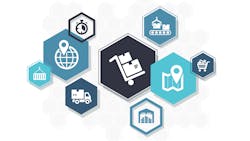Download this article in PDF format.
To say 2020 was a year of change would be a major understatement, and the procurement sector didn’t escape the numerous forces that impacted the world over the last 12 months. The global pandemic, the U.S. presidential election, and protests over social and racial injustice were among the most publicized events, but the devasting forest fires, active hurricane season and persistent supply chain disruptions also exacted a toll on human life, livelihoods and organizations.
While the persistent supply chain interruptions kept buyers on their toes, other, less-catastrophic trends were also playing in the back of their minds throughout the year. For example, many of their organizations were already in the midst of a digital transformation (or, at least planning for one) when COVID-19 emerged and accelerated that timeline.
The Automated Supply Chain
In “Full Speed Ahead: Automated Supply Chains Proliferate in the Global Pandemic,” we reported that long before the words coronavirus and COVID-19 became a part of our everyday vocabulary, companies were investing in automation that promised to improve efficiencies and speed up processes. Whether that meant adding “cobots” to distribution center floors, using artificial intelligence (AI) for better decision-making, or deploying automated storage and retrieval systems (AS/RS) in fulfillment centers, the adoption of automated systems was already growing year-over-year.
There’s more to come. According to a recent Oxford Economics report, 12.5 million manufacturing jobs will be automated in China by 2030. “In the aftermath of the pandemic, it could be many more,” Shahin Farshchi writes in “Expect More Jobs and More Automation In The Post-COVID-19 Economy.”
“We have yet to see how the global pandemic will impact jobs in the long term,” Farshchi writes, “but it’s safe to assume that we will see acceleration in automation where it keeps human workers, and consumers, safer.”
Reducing Supplier Risk
Buyer-supplier relationships also came into closer focus in 2020—a year when even basics like toilet paper became scarce enough to start hoarding in bathroom closets nationwide. Electronics buyers dealt with their own levels of product scarcity throughout the year, as we reported in “Key Trends Shaping the Future of Procurement.”
In a world where supply chain risk is top of mind for most electronics buyers, technology continues to play a role in easing that pain point. According to EY, most organizations will have a 360-deg. view of suppliers through internal data, data from suppliers, market data and external data on suppliers’ performance (e.g., performance of suppliers with other organizations). “This will not only provide historical data about supplier performance,” EY states, “but will also enable organizations to accurately and holistically establish supplier risk profiles and to predict risk events.”
More Supplier Diversity
Originally introduced in 1953 with the establishment of the U.S. Small Business Administration (SBA), supplier diversity programs were designed to give minorities, women and the group since classified as underutilized small business owners an opportunity to secure contracts with government agencies, major companies and corporations as qualified-small business suppliers.
Fast-forward to 2020 and the concept of supplier diversity has evolved into “an array of small business owners from all ethnic, racial, gender and disadvantaged groups providing products and services to government agencies, as well as major companies and corporations,” the SBA states. In “Using Supplier Diversity to Gain Competitive Advantage,” we outlined the key gains that have been made in this area and discussed how far companies still have to go.
An inclusive procurement strategy widens the pool of potential suppliers and promotes competition in the supply base, which can improve product quality and drive down costs. “And by providing more sourcing options,” HBR states, “inclusiveness can make supply chains more resilient and agile—an increasingly important advantage in these uncertain times.”
In “6 Supplier Diversity Challenges To Overcome In 2020,” Krista Zuber talked about how issues like unintentional human bias, difficulties defining who is/isn’t a diverse supplier and finding qualified diverse suppliers can all derail the best-laid diversity plans. Program goals can also conflict with cost-reduction goals—a major challenge for procurement in this challenging business environment. Fortunately, savings and supplier diversity goals don’t have to be at odds.
Supply Chain Resiliency
A term that’s being thrown around a lot right now, resilience is the capacity to recover quickly from difficulties. Applied in the supply chain realm, resilience means being prepared for the unexpected, and responding to and recovering from potential risks quickly. In “Can We Make Our Global Supply Chains More Resilient?,” we looked at how the global pandemic and the subsequent supply chain challenges forced a lot of organizations to come to terms with their low levels of supply chain resilience.
And in “5 Procurement Shifts for the Post-COVID World,” we put supply chain resilience first on a list of things buyers can be doing now to prepare for a time when the global pandemic is firmly in their rear-view mirrors.
“In the past several years, at least one company in 20 has suffered a supply chain disruption costing at least $100 million,” McKinsey points out in “Reimagining procurement for the next normal,” noting that companies with complex supply chain networks (i.e., automotive and technology manufacturers) are particularly vulnerable. “The time is right to do a thorough assessment of supply chain risks and manage them more thoughtfully.”
About the Author

Bridget McCrea
Contributing Writer | Supply Chain Connect
Bridget McCrea is a freelance writer who covers business and technology for various publications.







